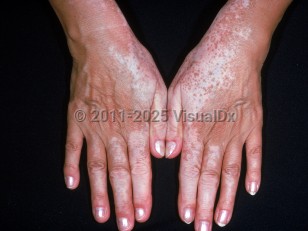Drug-induced hypopigmentation is most commonly associated with topical agents, such as after prolonged use of topical steroids or retinoic acid. Intralesional, intraarticular, and inhaled corticosteroids have also been associated with local hypopigmentation or depigmentation. The onset may be delayed for up to 4 months. A progressive linear configuration of hypopigmentation has been reported following both intralesional and intraarticular corticosteroid injection. It is thought that this occurs secondary to lymphatic or venous infiltration that occurs at the time of administration. Topical phenols and catechols may cause a vitiligo-like depigmentation at sites of contact (see chemical leukoderma).
Oral drugs have also been noted to cause hypopigmentation:
- EGFR inhibitors (gefitinib), Bcr-abl inhibitors (imatinib and dasatinib), VEGFR inhibitors (pazopanib, sunitinib), BRAF inhibitors (vemurafenib), and interleukin-2 (IL-2) have all been reported to cause hypopigmentation. While hyperpigmentation may occur from imatinib, hypopigmentation is more common. Its onset is typically gradual, and focal or generalized presentations may be seen. Worsening of vitiligo has also been reported with imatinib.
- Tranexamic acid – Decreases the production of prostaglandins, which are the precursor of tyrosine.
- Chloroquine has been reported to cause vitiligo-like depigmentation, as have the PD-1 inhibitors pembrolizumab and nivolumab. New-onset vitiligo on ipilimumab is reported, and this has been associated with a better therapeutic response.
- Arsenic – Can cause raindrop-like hypopigmentation and predispose patients to skin cancer.
Regarding the hair, hypo- or depigmentation may be seen with chloroquine, hydroxychloroquine, sunitinib, pazopanib, dasatinib, and imatinib. In general, this effect is reversible when medication dosage is lowered or the drug is discontinued.
Related topic: vitiligo



